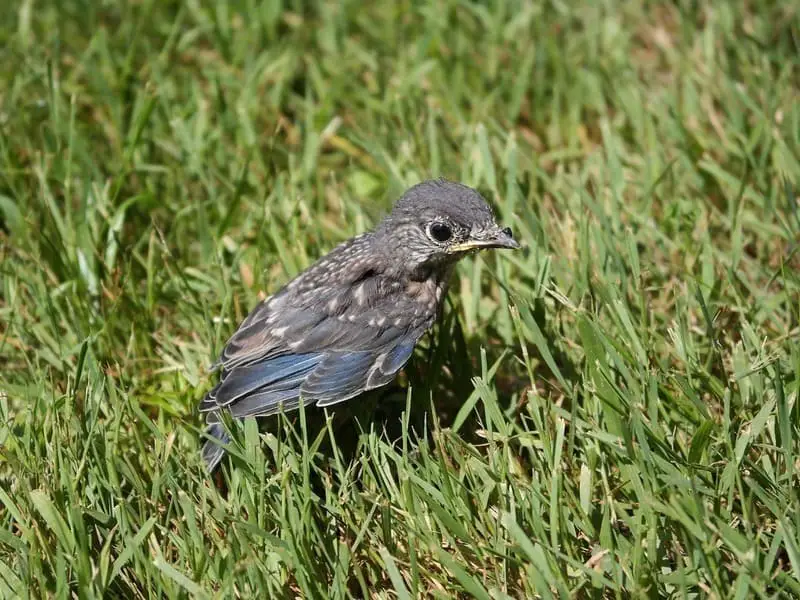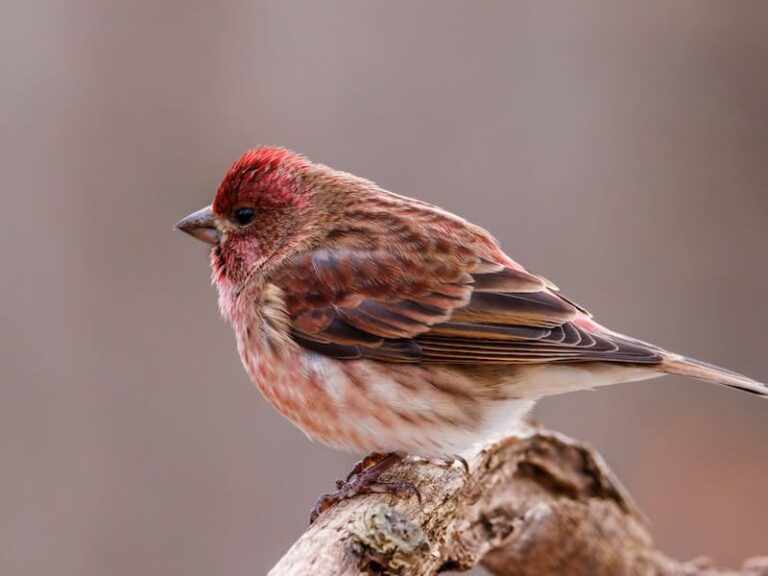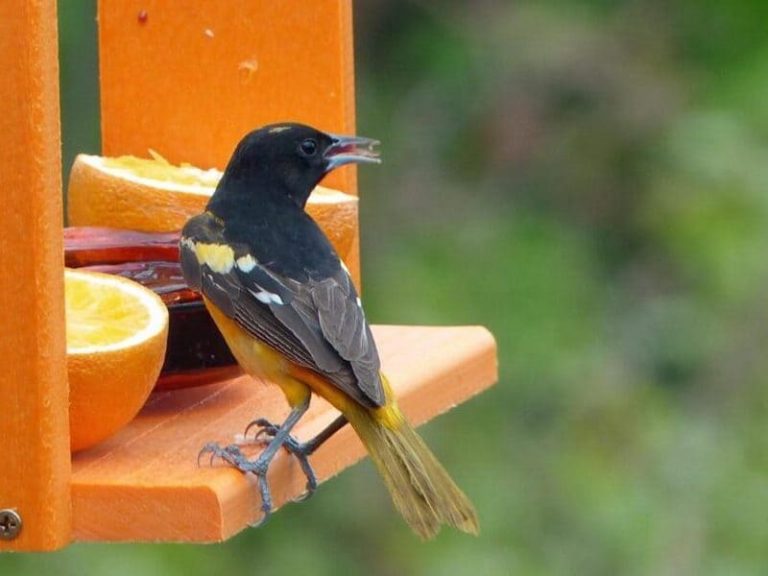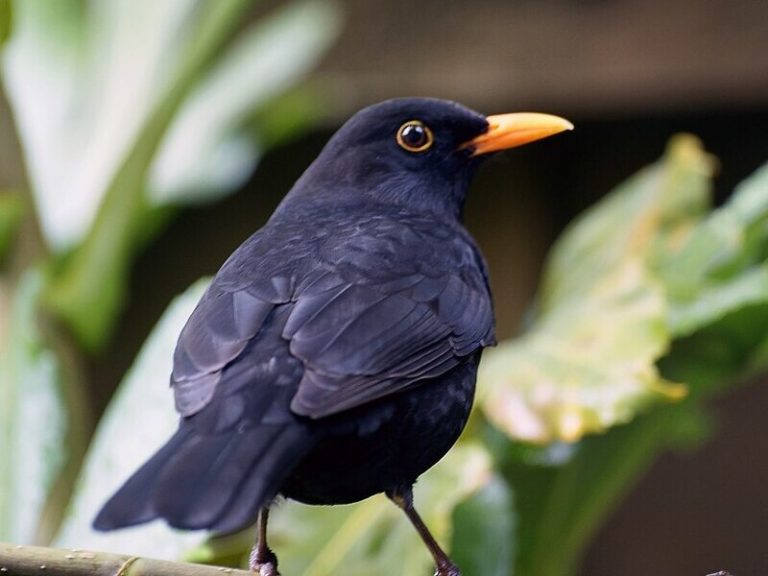What Do Baby Blue Jays Eat?

Have you ever spotted a baby blue jay outside and wondered what its diet is? With the amount of energy, these little birds exude, you’d assume that they would need plenty of food.
But what do baby blue jays eat? It turns out there’s actually a wide range of foods that make up the diet of these feathered blues.
From juicy worms to fresh fruits and nuts, we’ll take a closer look at the different types of food items this type of bird enjoys in this blog post! Read on to learn more about Blue Jay’s nutrition habits.
What do baby blue jays eat?
Baby blue jays eat insects, seeds, grubs, and fruit. Insects are their main source of food and can be found in the wild or purchased in pet or feed stores. Some bluejays enjoy dried mealworms or beetles which are a popular choice for wild birds.
Seeds provide nutrition and variety as different types provide different vitamins and minerals. Grubs and larvae from various insects can also meet their dietary needs depending on the type of larva consumed.
The occasional berry or slice of apple provides a treat for a baby bluejay’s sweet tooth too. With so much nutritious food to choose from, baby bluejays have all the energy needed to learn about the world around them.
Do baby blue jays eat worms?
Baby blue jays have a more diverse diet than their adult counterparts. While adults tend to reside in seeds, berries, and insects, such as small caterpillars and beetles, juvenile birds expand their foraging to include softer items like earthworms.
Baby blue jays will often feed on earthworms when they’re still learning how to hunt for food. Earthworms provide key nutrients that help baby blue jays grow into strong and healthy adults.
In addition, earthworms are an easier target than larger prey since they can be ingested in one piece and require less effort to catch and consume. As such, it is no surprise that baby blue jays do indeed eat worms.
Recommended article: What Do Baby Robins Eat?

Do blue jays like acorns?
Blue jays are one of the few species of bird known for their fondness for acorns, making them easily recognizable in an outdoor scene.
Depending on their accessibility and availability, blue jays may consume more tree nuts than other types of food. For example, when acorn woodpeckers store large quantities of acorns in trees, blue jays will actively search for them.
They are also known to hide extra nuts for later consumption as well as use a unique form of bartering with other birds in exchange for food. These small birds have an appetite that is both creative and clever!
Do baby blue jays also eat eggs?
Baby blue jays, like their adult counterparts, are omnivorous creatures, enjoying a wide variety of food items in their diet.
Most commonly, baby blue jays rely on insects and fruits as they grow while also learning many survival techniques from their parents.
However, ever the resourceful birds that they are, baby blue jays have been known to supplement their diet with eggs when the opportunity presents itself.
While not an integral part of a baby blue jay’s diet, there is certainly evidence of these birds enjoying the occasional egg amidst their menu of insects and fruit.
How to feed baby blue jays
Caring for baby blue jays is a rewarding experience that can bring joy to bird lovers of all ages. Learning how to feed them properly, however, can be tricky.
Baby blue jays need a diet made up of insects and soft fruits, supplemented with birdseed and egg food available from local pet stores.
They should be fed several times per day, with parental birds bringing food to the nestlings until they develop the skill of foraging for themselves.
Even after developing these skills, baby blue jays will continue to rely on their parent’s guidance as they continue to develop and eventually flee from the nest.
Providing proper nutrition for baby blue jays is paramount for ensuring their continued success and health later in life.
The blue jay diet

The diet of the blue jay is incredibly varied, from being opportunistic feeders to having favorites among their available food sources.
They typically forage for seeds, fruits, and insects on the ground, in trees and bushes, and even in mid-air as they snatch up flying insects.
They have been known to also scavenge from bird feeders in urban areas and from fisherman’s bait stores. Blue jays will also store astoundingly large quantities of food items such as acorns or hazelnuts in order to save them for later consumption.
This helps them get through rough patches or major storms in which the availability of food options is slim. While the blue jay usually prefers living sources of nourishment like insect prey or wild fruits, they can apparently survive off processed foods as well within urban environments.
Nuts
Blue jays rely mainly on nuts for their diet, often eating acorns, beech nuts and sunflower seeds. They also feed on grains, fruits, and insects.
Nuts are an important source of carbohydrate which provides energy for the birds to survive the winter months when food is scarce.
While blue jays prefer softer nuts, they can crack harder nuts such as chestnuts with their strong bill. This is made possible by a specialized area in their throat muscle that helps them store and crack nutshells.
In addition to providing a reliable source of food during times of scarcity, blue jays help spread nut-bearing trees throughout forests by carrying and discarding the seeds elsewhere.
As a result of this behavior, blue jays play an important role in the overall health of local ecosystems.
Berries
It’s no secret that blue jays are some of the most colorful avian creatures around. It doesn’t stop at just their iconic blue feathers, however; their diets are also quite intriguing.
To sustain themselves, blue jays rely heavily on berries, as they make up a significant portion of their diet.
Not only do they get hydration from the berries, but they also receive important vitamins and minerals that help keep them healthy and strong.
Additionally, berries give them a good amount of energy to do what they need to do during the day; this helps them fly with greater agility or compete in aerial fights with other birds!
Worms
Worms are an important part of the diet of a blue jay, along with other items like nuts, seeds, grains, and succulent fruits. While they do scavenge for food in gardens and feed stations, they prefer to hunt insects as their main source of sustenance.
For this reason, they will often be found hunting for worms in the earth around them or spotted snatching them out of shallow water. Blue jays have incredibly sharp vision and can spot a target oftentimes before any other animals.
While humans might be afraid of touching worms, blue jays have no problem diving into mud or dirt to get the tasty treats that await beneath.
Worms not only provide an energy boost from their protein-rich bodies but also are an important source of calcium due to the soil that clings to these slithery organisms.
Grasshoppers
Blue jays are fascinating creatures that have an amazing diet, including grasshoppers!
These colorful birds feed on a variety of insects and small animals, primarily preferring to feast on grasshoppers as they’re easy to catch since they can’t fly all too fast.
They’ll typically stalk slowly in the grass until they locate the grasshopper, then pounce with lightning speed and accuracy to snag it.
Blue jays are the perfect environment keepers, eating up those pesky bugs that might otherwise overrun us.
They even remember where they stored food during winter times, so don’t be deceived by their seemingly sluggish behavior when temperatures drop. It’s always rewarding watching them stock up for colder months.
Beetles
Beetles play an important role in the diet of blue jays. They provide essential nutrients which help the birds grow and flourish. Besides providing energy, they help to promote bone growth as well due to their high mineral content.
Beetles also promote healthy gut flora since they are full of fiber and nutrients that aid digestion. Blue jays take great advantage of these benefits, often foraging for beetles a few times each day.
Swooping down to catch them mid-flight or plucking them from piles of leaves is a sight to be seen, especially in the summer.
Beetles have been a crucial part of the blue jay diet for centuries and will continue to serve a vital role in their lives for many years to come.
Favorite foods of a baby blue jay
Baby blue jays are remarkable birds with a wide array of interesting favorite foods. Contrary to popular belief, these delightful creatures enjoy more than just insects and nuts. In fact, they actively seek out juicy fruit, seeds, and grains.
Interesting research has found that baby blue jays will also feed on unique items such as snails, frogs, and small lizards in order to fulfill their nutritional requirements.
Additionally, they prefer softer food sources since they can’t open hard shells as adults can.
As a result, their diet makes for an interesting combination of bugs and delicious berries that delight all those lucky enough to witness this unique behavior.

Soft food
Baby blue jays eat a wide range of soft foods like insects and berries. They usually wait in trees for the parents to bring these delicacies, but they can also find them on the ground or in foliage.
Insects such as moths, grasshoppers, and caterpillars are preferred as they contain plenty of lipids and proteins essential to growing birds.
Fruits like mulberry, serviceberry, juniper berry, and dogwood berry are often staples of the baby bird’s diet since they provide necessary carbohydrates.
During the early days of being a chick, these small guys must have at least five feedings throughout the day in order to grow healthy and strong!
Canned pet food
Canned pet food for bluejays makes a great complete meal for these beautiful birds. Not only is it filled with all the essential vitamins and minerals required to maintain health, but its soft texture also makes it an appealing and easy-to-consume option.
Depending on the variety, canned pet food can also provide specific benefits that are tailored to fit the needs of a blue jay’s diet, such as omega-3 fatty acids or lutein. It can be served as is or mixed with fruits, grains, and other treats to create a healthy and tasty meal.
By offering canned pet food for blue jays, your feathered friend will enjoy a balanced diet each and every day!
Why did a blue jay attack me?
It’s normal to feel surprised or scared when a blue jay suddenly swoops down to attack. It might seem like the bird is out of nowhere, but there’s usually a good explanation for its behavior.
The most common reason a blue jay might attempt to attack is that it perceives a threat to its territory or young.
Blue jays are strongly territorial and use their conspicuous calls and behaviors to defend their domains. The bird may have mistaken me for an intruder and flown in for an assertive warning.
Alternatively, I may have accidentally stepped too close to its nest; this could have caused the parent blue jay to become defensive and lash out with an attack.
No matter what the reason may be, understanding why blue jays behave aggressively can help put our minds at ease. It’s simply part of their nature!
Really raid other bird’s nests?
The Blue Jay has the reputation of being a thief among other species of birds. While this may be true, Blue Jays have been known to turn quite defensive when raiding another bird’s nest is suggested.
Studies show that Blue Jays are actually scavengers and are more likely to steal food from below than steal eggs or chicks from above.
They can also be important predators of many pest insects, which benefits other birds in the area by eliminating competition for resources. While Blue Jays could theoretically raid nests, their behavior seems to suggest otherwise.
What do I feed a baby blue jay?
A baby blue jay, or nestling, must be fed a nutritionally balanced diet to prepare it for life in the wild. During their first couple of weeks of life, they should be offered moistened, finely grated dog food mixed with formula and insects like crickets, wax worms, silkworms, and mealworms.
As they mature and feather out, they can progress to canned cat food. Later on, they may enjoy seeds like sunflower and crushed almonds as well as various fresh fruits and vegetables.
To ensure full nutrition, swivel chop a variety of insects with prepackaged foods and vitamins available at pet stores for bird feeders like softbill mixes.
What do you do if you find a baby blue jay?
If you come across a baby blue jay, the first thing you should do is make sure it is actually orphaned. If it is alone and making frequent noise, or it appears to not have adult birds taking care of it, then it means that the bird needs assistance.
Depending on its age, you should find a rehabilitation center that can care for it accordingly so they can give the bird the best chance at survival.
You may need to feed the baby bird until you are able to get him or her to a proper facility, but be sure to check with the experts for what type and amount of food will be best for their health.
Although trying to care for this bird yourself may feel like the most humane response, only trained professionals will be able to provide ideal care.
Can baby blue jays eat bread?
Baby blue jays are a vibrant and beloved species of backyard birds. While it can be tempting to feed them the same food we do, bread is not an ideal snack for these feathered friends.
Bread lacks any nutritional value that suits a baby blue jay’s needs, so while songbirds seem to enjoy it, it’s not recommended in their diet as a steady source of sustenance.
Humans should instead offer up more suitable snacks, like cracked corn, millet, peanuts, and other bird seeds livened up with occasional insects when available.
Feeding these treats is a great way to get closer to nature and watch the fascinating behaviors that unfold among the birds in your very own backyard.
How long does it take a baby blue jay to fly?
It appears that baby blue jays take a few weeks to learn how to fly. By the time they are about three to four weeks old, these majestic birds can often take short flights, but it takes them another 4-6 weeks of practice and monitored development until they can fly confidently.
During this learning period, their parents help them out by bringing prey back to the nest, teaching the young birds what they need in order to reach graceful heights on their own.
It’s always incredible to watch baby blue jays practice their wings, as it is a sight that brings us closer to nature, one bird at a time!
Final words
Baby blue jays are born without feathers, and their beaks are not fully developed, so they are unable to eat on their own.
The female will continue to feed them until they are about 7-10 days old, when they develop their first feathers.
After that, the baby blue jays will start eating on their own but will still beg for food from their parents.
It is important for baby blue jays to learn how to find food and recognize different types of food, as this will help them survive in the wild.
You will also like to read:






